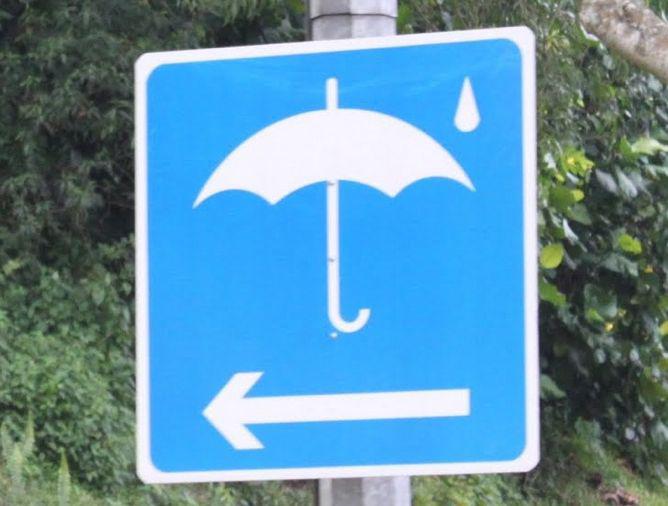It’s time for our first Southeast Asian edition of What’s That Thing, Slate’s column examining mysterious or overlooked objects in our visual landscapes. Wondering about something—on or off road, at home or abroad? Drop us an email.
Nothing awakens a traveler’s senses like his or her very first hours in a new place. Every time I leave Singapore’s Changi Airport by bus or taxi, I’m astounded all over again by the public greenery—the multicolored flower beds, the vine-drenched overpasses, the trees so flawlessly coiffed that from any distance at all they resemble bonsai.
Singapore’s long-standing ambition has been to be a growing metropolis in every sense, to become not a city with lots of gardens, but a city in a garden. Singaporeans are wealthier than almost anyone, and it looks to me like all that extra cash is going into landscaping. Even some of the biggest highways are less like the Dan Ryan or the Van Wyck and more like parkways built for scenic drives through a particularly fecund botanical exhibit.
The hothouse highways offer other points of interest to recently arrived bleary-eyed foreigners. There’s the curious spectacle of everyone driving the speed limit, for example. And the blue “death tents” that often conceal bodies at accident scenes. Near the airport is a straight run of busy highway, designed to function as an emergency runway, where the flowers in the median grow in readily removable flower pots.

Courtesy of the Land Transport Authority of Singapore
Then there are signs like the one pictured above. An umbrella, a lonely raindrop, and in some cases, an arrow. A euphemism for fallout shelters? Directions to an umbrella district? To a Mary Poppins theme park?
These signs are dotted around the island. Like many expats and travelers, Naomi Hattaway—an American blogger and relocation agent who moved from Delhi to Singapore in 2012 before recently returning to the Washington, D.C., area—wondered about them when she first arrived.
The answer, as Hattaway puts it, is “pretty cool and ingenious.” The signs lead to designated covered areas where motorcyclists can safely wait out a downpour.

Courtesy of the Land Transport Authority of Singapore
If foreigners aren’t familiar with these shelters, few will have ever seen the skies open like they do here. The city-state averages around 90 inches of rainfall per year. That’s more than Hong Kong or monsoonal Dhaka, Bangladesh. It’s more than Seattle and Vancouver combined. And Singapore’s tropical rain often comes in heavy, short-lived sky-Niagaras.
Foreigners describe these shelters as “very Singaporean.” Indeed, the peculiarities of Singapore’s weather—not to mention its wealth, obsession with urban design, and diminutive geographic dimensions (the country would fit inside Lexington, Kentucky, with room to spare)—explains why these shelters make particular sense here.
Do they exist elsewhere? Peter ter Horst, a spokesman for the American Motorcyclist Association, told me that “the concept of a public roadside bike shelter to escape inclement weather is not familiar to us.” James Jamieson, a spokesperson for South Africa’s Christian Motorcyclists Association, told me he’s never seen such shelters in his country. Surely Britain—small, and as rich as it is rainy, has them? Graeme Hay, with the British Motorcyclists Federation, pointed out that British rain rarely falls in the “catastrophically high-volume deluges that tropical climates experience.” Anyway, London gets only a third of Singapore’s annual dose of downpours.
But that doesn’t mean that such shelters wouldn’t be a boon to bikers in other countries. They might even save lives. The AMA’s ter Horst points out that in the worst conditions bikers may take shelter under bridge overpasses—a risky business indeed, especially when cars and trucks are coping with reduced visibility and extended stopping distances. (Singapore’s shelters may be sited on the outside of the supports for just such overpasses.)
Marilynn Bastedo, a spokeswoman for the Canadian Motorcycle Association, said she hasn’t seen any such Singapore-caliber shelters in Canada. “It is a terrific idea, though,” she added, “and one we should pursue with the provincial governments.” Hear, hear.
Click here to read a hundred other reasons to be happy in Singapore, and here to read the death penalty warnings on the “Welcome to Singapore” landing cards completed by arriving tourists (not that U.S. arrival procedures are much friendlier). And click here to submit suggestions for future columns—anything you’ve seen and wondered about, at home or abroad.
